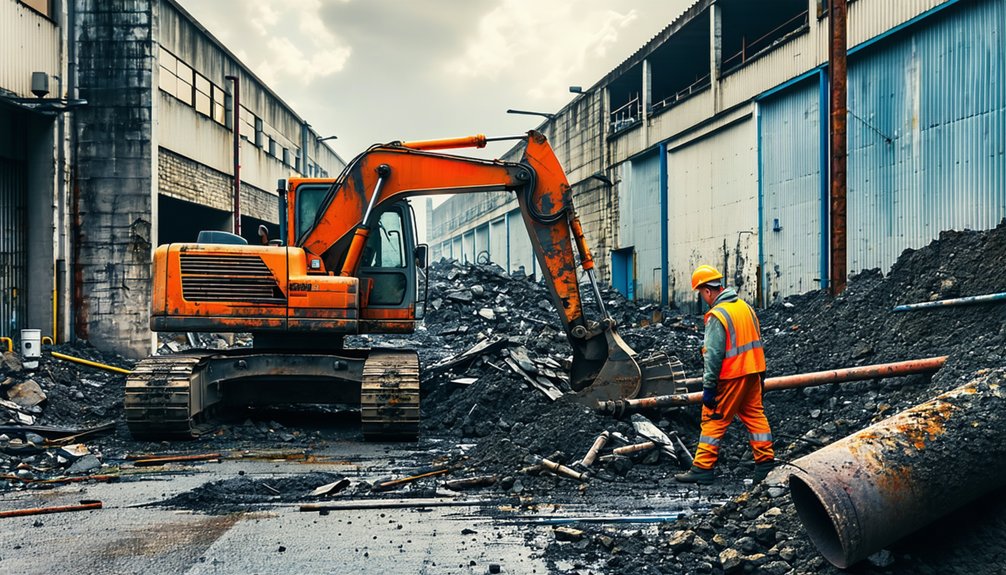Affordable sewer line replacement options primarily include trenchless methods, which can reduce costs by 30-40% compared to traditional techniques. Techniques such as pipe bursting and CIPP lining minimize excavation and surface disruption, with repair costs ranging from $3,500 to $12,000. Spot repairs with CIPP liners offer localized solutions for damaged pipes at a cost of $3,000 to $12,000. Further insights reveal various maintenance strategies that can enhance the lifespan of sewer lines.
Cost-Effective Solutions for Common Sewer Line Issues
While addressing sewer line issues can often be costly, several cost-effective solutions exist that can greatly reduce expenses for homeowners. Trenchless methods, such as pipe bursting and cured-in-place pipe (CIPP) lining, present significant savings, often reducing sewer line replacement costs by 30-40% compared to traditional excavation. Homeowners may incur costs ranging from $3,500 to $12,000 for trenchless repairs, a stark contrast to the $7,500 to $30,000 typically associated with traditional methods for just 30 feet of pipe. Spot repairs utilizing CIPP liners offer an additional affordable option for localized damage, with costs between $3,000 and $12,000. In addition, annual applications of maintenance solutions like RootX can help mitigate root intrusion issues, although their effectiveness is limited in damaged existing pipes. These alternatives not only provide cost savings but also minimize disruption, thereby offering homeowners viable paths to restore their sewer systems efficiently.
Comparing Trenchless Methods vs. Traditional Excavation
How do trenchless methods compare to traditional excavation when it comes to sewer line replacement? Trenchless methods, including pipe bursting and cured-in-place pipe (CIPP), offer several advantages over traditional excavation techniques. Primarily, these methods markedly reduce sewer line replacement costs, often by 30-40%. Traditional excavation can lead to extensive repairs that range from $7,500 to $30,000, while trenchless options typically cost between $3,500 and $12,000 for similar lengths.
Trenchless methods significantly cut sewer line replacement costs by 30-40% compared to traditional excavation.
Key comparisons include:
- Minimal excavation: Trenchless methods require only access holes, reducing surface disruption.
- Faster installation: Homeowners experience less downtime.
- Advanced diagnostics: Techniques like sewer camera inspections assess pipe conditions efficiently.
- Lower repair costs: Affordability is a key benefit.
- Less labor-intensive: Traditional methods often lead to increased labor costs due to extensive digging.
Ultimately, trenchless methods present a more efficient and cost-effective solution for sewer line issues.
Maintenance Tips to Extend the Life of Sewer Lines
To guarantee the longevity of sewer lines, regular maintenance is essential. Implementing a routine schedule of inspections using a sewer camera allows for the early identification of potential issues, reducing the likelihood of costly sewer line repairs. Maintenance tips include hydro jetting or snaking to effectively clear blockages and prevent tree roots from infiltrating pipes. Homeowners should avoid flushing non-biodegradable items and disposing of grease or food scraps, as these practices can lead to clogged drains and damage over time. Annual treatments with root-killing solutions, such as RootX, are advisable for managing root growth, particularly in clay pipe material. Additionally, keeping accurate records of maintenance activities guarantees informed future preventive measures. By adhering to these practices, property owners can extend the life of their sewer lines and mitigate long-term expenses.
Frequently Asked Questions
What Is the Cheapest Way to Replace a Sewer Line?
In the domain of sewer line replacement, cost-effective methods abound, inviting homeowners to explore their options. Trenchless technology, such as pipe bursting or CIPP lining, stands out for its efficiency and affordability. Meanwhile, DIY replacement tips and awareness of municipal assistance programs can further reduce expenses. Financing options and contractor negotiations, paired with preventive maintenance, help guarantee compliance with local regulations while facilitating material comparisons for ideal choices.
What Is the Average Cost of a New Sewer Line?
The average cost of a new sewer line installation typically ranges from $3,000 to $25,000, influenced by factors such as the chosen sewer line materials and installation methods. Trenchless technology offers a cost-saving plumbing alternative, reducing expenses by 30-40%. Plumbing maintenance tips, including regular sewer line inspections, can preempt plumbing emergencies. For those with DIY skills, minor repairs may be feasible, enhancing drainage solutions while managing costs effectively within municipal sewer systems.
Does Homeowners Insurance Cover Sewer Line Replacement?
Homeowners insurance typically offers limited coverage options for sewer damage, primarily addressing sudden incidents rather than gradual deterioration. Policy details vary widely; exclusions listed may include maintenance issues, requiring homeowners to understand their responsibilities. To cover repair costs effectively, additional riders may be necessary. Thorough documentation and professional estimates can aid in the claims process, while underwriting factors should be reviewed to guarantee adequate protection against unexpected sewer line events.
What Is the Alternative to Underground Plumbing?
In a world once dominated by cumbersome trench digging, alternative plumbing methods have emerged, revolutionizing sewer line repairs. Above ground solutions, such as trenchless technology, utilize techniques like pipe bursting and PVC pipe options, minimizing disruption. Cast iron alternatives offer durability, while eco-friendly materials enhance sustainability. Plumbing inspections can identify issues early, and DIY plumbing fixes empower homeowners, providing flexibility and efficiency in their plumbing systems, ultimately redefining modern plumbing practices.



